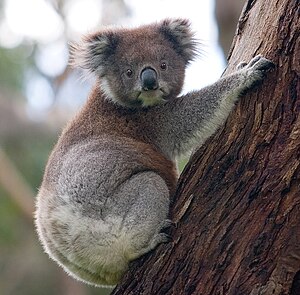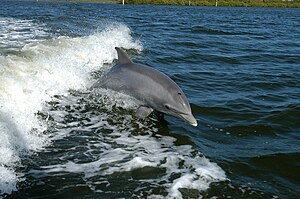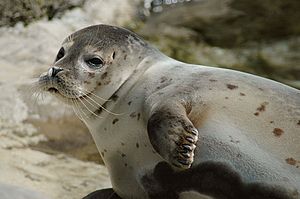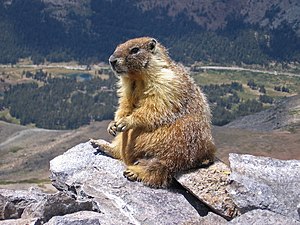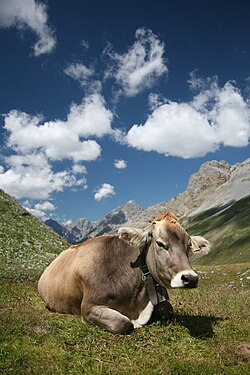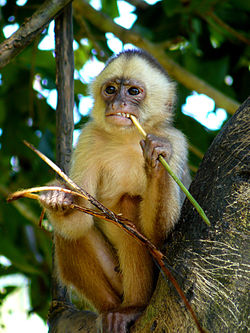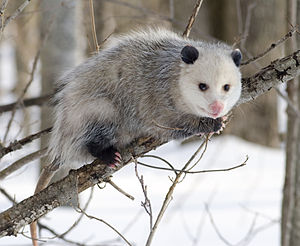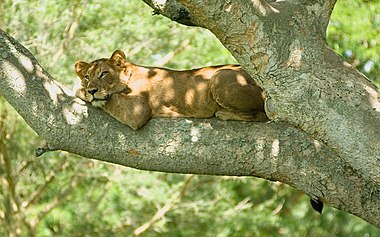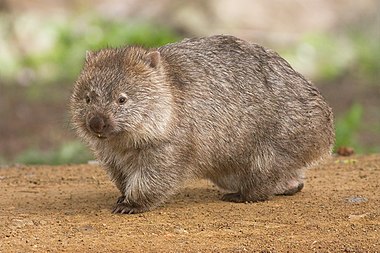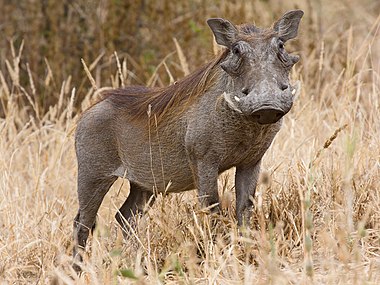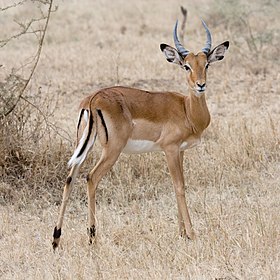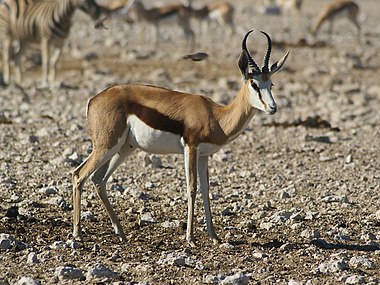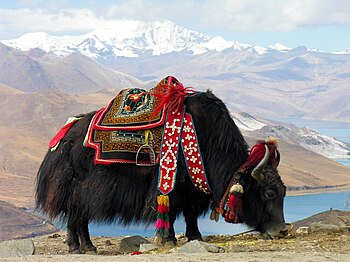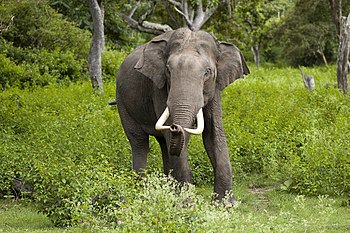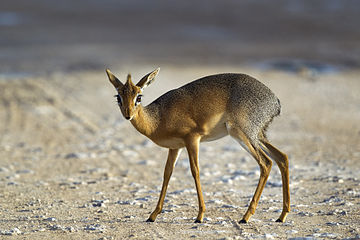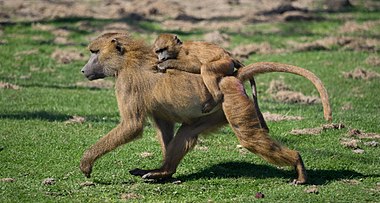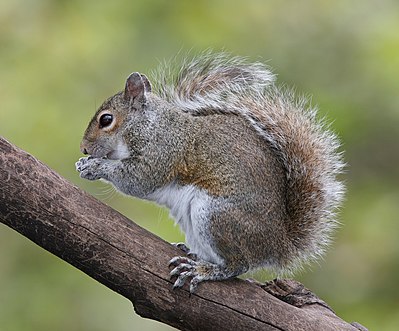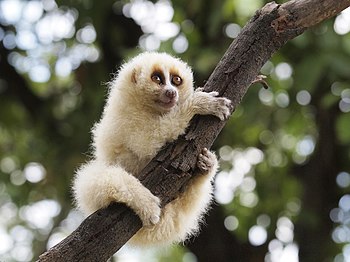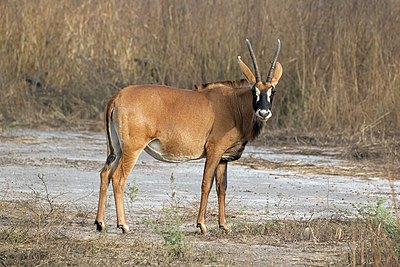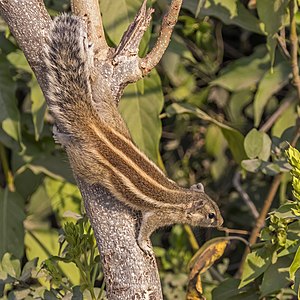The Selected picture box on the portal chooses one of the following at random when displaying the page. Follow the instructions below for adding or nominating a new picture to the list.
Picture candidates
Feel free to add related featured pictures to the list. Nominate other pictures on the portal talk page.
- Pictures must be
- Free to use and hosted on
Commons
- Of good quality (not blurred, grainy or discoloured)
- Interesting
- Relevant to an article or topic
To find appropriate pictures, use search box below:
Instructions
- For pictures, which appeared as picture of the day on the Main Page, just add the date in
YYYY-MM-DD format to the list (please keep the list sorted).
- For other pictures, use following parameters:
|iN=
|titleN=
|creditN=
|captionN=
where N is the next unused number.
Selected pictures list
Template:POTD/2004-05-15
The
cat is a small
feline carnivorous mammal that has been
domesticated for several millennia. A male cat is usually called a tom cat, a female cat is called a queen. A young cat is called a kitten (as are baby rats, rabbits, hedgehogs and squirrels).
Template:POTD/2004-07-21
Template:POTD/2004-07-23
human anatomy
. In animals, the head end is called the "cranial end" and the tail end is the "caudal end". The side of the body normally oriented upwards is the "dorsal" side; the opposite side, typically the one closest to the ground when walking on all legs, swimming or flying, is the "ventral" side.
Template:POTD/2004-09-28
newborn to climb to the pouch and attach to a
teat
Template:POTD/2007-01-17
. It has black facial colorings around the eyes, and has a bushy tail with light and dark alternating rings. The coat is a mixture of gray, brown, and black fur. The characteristic eye colorings make the animal look like it is wearing a "bandit's mask," which has enhanced the animal's reputation for mischief, vandalism, and thievery.
Template:POTD/2007-02-02
A male
lion (
Panthera leo) lying down in
Namibia. One of the four "
big cats" in the
genus Panthera, the lion is the second largest cat, after the
tiger. Males weigh between 150-250 kg (330-550 lb), and are easily recognizable by their manes. Though they were once found throughout much of
Africa,
Asia and
Europe, lions presently exist in the wild only in Africa and
India.
Template:POTD/2007-02-24
Template:POTD/2007-04-06
Template:POTD/2007-04-08
program, with at least fifty individuals in the wild.
Template:POTD/2007-04-13
Red Squirrels and have no natural predators, which has added to their rapid population growth and has led to the species being classed as a
pest
Template:POTD/2007-05-03
Short-beaked Echidna (
Tachyglossus aculeatus), also known as the
Spiny Anteater because of its diet of
ants and
termites, is one of four living species of
echidna. The species is found throughout
Australia, where it is the most widespread native
mammal, and in coastal and highland regions of southwestern
New Guinea
Template:POTD/2007-07-14
Template:POTD/2007-07-30
A black-tailed
prairie dog at the
National Zoo in
Washington, D.C., looks out from a system of
burrows, characteristically scanning the horizon. On average, these rodents grow to between 12 and 16 inches (30 and 40 cm) long, including their short tails.
Template:POTD/2007-09-06
Cape buffalo in Northern Sabi Sand,
South Africa. Lions are true
predators who can require an average of up to seven kilograms (15 lbs) of meat daily to survive. Large
mammals
Template:POTD/2007-12-26
coniferous
forests, and typically above 2,000 metres (6,562 ft) of elevation.
Template:POTD/2007-12-28
A
lioness in Ishasha Southern sector of
Queen Elizabeth National Park,
Uganda. Ishasha lions are famed for tree climbing, a trait only shared with lions in the
Lake Manyara region. They often spend the hottest parts of the day in the large
fig trees found throughout the area. It is still unclear why so few lions exhibit this behavior.
Template:POTD/2008-01-26
blowholes
, creating a ring of bubbles up to 30 m (100 ft) in diameter. The whales then suddenly swim upwards through the bubble net swallowing thousands of fish in each gulp.
Template:POTD/2008-02-05
A
dromedary or one-humped camel (
Camelus dromedarius) in the
Australian Outback. Estimated populations of
Australian feral camels are in the hundreds of thousands, and this is now the world's only population of dromedaries exhibiting wild behaviour. Thousands of camels were imported into Australia between 1840 and 1907 to open up the arid areas of
central and
western Australia. They were used for riding, and as draught and
pack animals for exploration and construction of rail and telegraph lines; they were also used to supply goods to remote mines and settlements. Their impact on the environment is not as bad as that of other
introduced pests in Australia. They prefer to eat trees and plants that local wildlife dislike; only 2% of their diet is grass.
Template:POTD/2008-03-16
Template:POTD/2008-03-24
. The name was first intended as a joke, but has become the official scientific name.
Template:POTD/2008-04-12
Photo credit: Pascal Blachier
Template:POTD/2008-04-28
. In the summer, elephant seals undergo a catastrophic moult, lasting about one month, during which they lose much of their fur and skin. They spend this time on beaches to preserve body heat, while they wait for the new fur to grow.
Template:POTD/2008-05-22
Template:POTD/2008-06-06
Mediterranean Region and much of
Asia
Template:POTD/2008-07-17
Template:POTD/2008-09-05
Golden-mantled Ground Squirrel (
Spermophilus lateralis) is a species of
squirrel native throughout
North America and can be found in a wide variety of forest habitats as well as rocky meadows, and even sagebrush flats. It can be identified by its
chipmunk
Template:POTD/2008-10-02
Brown Swiss cattle breed. Since the 1960s, Brown Swiss cattle have been crossed back into the Braunvieh stock of
Europe
Template:POTD/2008-12-29
A 2-month old
domestic goat (
Capra aegagrus hircus) kid in a field of
capeweed. Goats are one of the oldest domesticated species. For thousands of years, goats have been used for their
milk,
meat, hair, and skins over much of the world. Female goats are referred to as
does or
nannies, intact males as
bucks or
billies; their offspring are
kids.
Template:POTD/2009-04-22
Wild Boar and the common farm pig (
Sus domestica), and originated in
Vietnam
Template:POTD/2009-05-31
. The blue eyes on this individual are uncommon among the species.
Template:POTD/2009-07-28
Template:POTD/2009-10-06
Red Kangaroo
is actually larger.
Template:POTD/2009-10-12
. Their upper parts are mottled, the fur containing a mixture of gray, light brown and dusky hairs. Head and body are about 30 cm (12 in) long and the tail an additional 15 cm (5.9 in).
Template:POTD/2009-11-08
Template:POTD/2010-10-08
Honey Badger, to scare away potential aggressors. Despite this, up to 90% of cheetah cubs are killed by
predators
Template:POTD/2010-12-27
Old Portuguese word
zevra which means "
wild ass
Template:POTD/2011-01-19
social animals, living underground in
groups of 20 to 50 members. Although the name means "lake cat" in
Dutch, meerkats are not
cats, nor are they attracted to
lakes
Template:POTD/2011-04-16
Indian Palm Squirrel (
Funambulus palmarum) is a
squirrel native to
India and
Sri Lanka. It is relatively small, about the size of a
rat, with three white stripes on its back from head to tail. According to
Hindu legend,
Lord Rama was so pleased with a squirrel's help in the construction of a bridge at
Rameswaram
Template:POTD/2011-05-26
particularly, twelve pairs of rabbits introduced in 1859 became millions in just ten years, the fastest spread ever recorded of any mammal anywhere in the world.
Template:POTD/2011-07-23
The
common wombat (
Vombatus ursinus) is one of three species of
wombat. It is native to south-eastern mainland
Australia and
Tasmania, and grows to an average of 98 cm (39 in) long and a weight of 26 kg (57 lb). It is solitary and lives in an underground burrow.
Template:POTD/2011-08-05
A female
Siberian tiger (
Panthera tigris altaica), a
subspecies of
tiger native to
Central Asia, and her cub. The Siberian tiger is the largest of the extant tiger subspecies as well as the largest
felid, attaining 320 kg (710 lb) in an exceptional specimen. Considered an
endangered subspecies, the wild population is down to several hundred individuals and is limited to eastern
Siberia.
Template:POTD/2011-08-15
Southern Elephant Seal (
Mirounga leonina), showing face and mouth detail. This species of
elephant seal is not only the most massive
pinniped, but also the largest member of the order
Carnivora living today. It is found throughout the
subantarctic
Template:POTD/2011-08-22
A female
koala (
Phascolarctos cinereus) with her
joey clinging to her back. At birth the joey is hairless, blind, and earless, and only about 20 mm (0.79 in) long. It remains hidden in the pouch for about six months, feeding only on milk. During this time it will grow ears, eyes, and fur. The joey will remain with its mother for another six months or so, riding on her back, and feeding on both milk and
eucalypt leaves until weaning is complete at about 12 months of age.
Template:POTD/2011-09-01
. Red-necked Wallabies can be found in the more temperate and fertile parts of eastern Australia. They can weigh 13.8 to 18.6 kg (30 to 41 lb) and attain a head–body length of 90 cm (35 in), with the island version slightly smaller.
Template:POTD/2011-10-12
Template:POTD/2011-10-28
Dharuk word
gula. English-speaking settlers from the late 18th century first called it "koala bear" due to its similarity in appearance to
bears, although they are not at all related. Instead, its closest living relative is the
wombat
Template:POTD/2011-11-26
European Hedgehog (
Erinaceus europaeus) is a
hedgehog species native to western and northern Europe. Adults are 20–30 cm (7.9–11.8 in) in length, weighing from 600 to 1,200 g (21 to 42 oz), depending on the season, with males slightly larger than females. It is
nocturnal, and if alarmed will roll itself into a ball, protecting itself against potential
predators
Template:POTD/2011-12-12
The
brown-throated sloth (
Bradypus variegatus) is the most common species of
three-toed sloth. It is found in the forests of South and Central America. Males and females are both about 42–80 cm (17–31 in) in total body length and weigh 2.25–6.3 kg (5–14 lb).
Template:POTD/2011-12-24
The
eastern chipmunk (
Tamias striatus) is a
chipmunk species native to eastern North America. Like other chipmunks, they transport food in pouches in their cheeks, as seen here. They eat bulbs, seeds, fruits, nuts, green plants, mushrooms, insects, worms, and bird eggs.
Template:POTD/2011-12-26
. Males reach around 12 kg (26 lb) in weight, 1–1.2 m (3.3–3.9 ft) in height, and are considerably larger than the females, which average 3.9 kg (8.6 lb).
Template:POTD/2012-02-13
Common Brushtail Possum (
Trichosurus vulpecula) is the largest
possum species and is perhaps the most widespread
mammal in Australia. It grows to about 32–58 cm (13–23 in) in length, with an additional 24–40 cm (9–16 in) for its
prehensile tail (seen here hanging below the branch). It is mainly a
folivore
Template:POTD/2012-03-01
Template:POTD/2012-03-14
The
eastern bettong (
Bettongia gaimardi) is a
marsupial whose natural range includes south-eastern Australia (where it has been
extirpated) and the eastern part of Tasmania. Sometimes referred to as a "rat-kangaroo", it is relatively small, rarely exceeding 2 kg (4.4 lb), but will travel up to 1.5 km (0.93 mi) from its nest to find food.
Template:POTD/2012-03-15
A
cast of the extinct
hominid species
Sahelanthropus tchadensis holotype cranium, dubbed "Toumaï", in facio-lateral view. The original cranial fragment is dated to about 7 million years ago and was discovered in Chad. Other than Toumaï, the only
Sahelanthropus remains to be discovered are five pieces of jaw and some teeth.
Template:POTD/2012-04-04
social animals (including humans) engage in to clean or maintain one another's body or appearance. Grooming also reinforces
social structures, family links, and builds
relationships. It has been best studied among
primates
Template:POTD/2012-04-29
The
warthog (
Phacochoerus africanus) is a wild member of the
pig family that lives in grassland, savanna, and woodland in
Sub-Saharan Africa. The
common name comes from the four large
wart-like protrusions found on the head of the warthog, which serve as a fat reserve and are used for defence when males fight.
Template:POTD/2012-05-09
The
impala (
Aepyceros melampus) is a medium-sized African
antelope. The name comes from the
Zulu language. They are normally reddish-brown, with lighter flanks, white underbellies, and a characteristic "M" marking on the rear. Males have
lyre-shaped horns, which can reach up to 90 cm (35 in) in length. They are strong jumpers, able to reach distances more than 10 m (33 ft) in a single bound. They are also fast runners, capable of reaching speeds up to 90 km/h (56 mph).
Template:POTD/2012-05-13
Template:POTD/2012-05-15
omnivorous, finding nutrition in almost any environment, and able to adapt with different
foraging
Template:POTD/2012-06-03
The
springbok is a medium-sized brown and white
gazelle native to southwestern Africa. It stands about 70 to 90 cm (28 to 35 in) high and is known for its jumping ability, being able to leap 4 m (13 ft) in the air and over a distance of 15 m (49 ft). It is also a fast runner, capable of reaching speeds up to 96 km/h (60 mph). The springbok is the
national animal of South Africa.
Template:POTD/2012-06-18
The
culpeo (
Lycalopex culpaeus, aka
Andean fox/wolf) is the second-largest native
canid in South America. It has grey and reddish fur, a white chin, reddish legs, and a stripe on its back that may be barely visible. The mean weight for males is 11.4 kg (25 lb), while females average 8.4 kg (19 lb).
Template:POTD/2012-07-29
The
European bison or
wisent (
Bison bonasus) is the heaviest of the surviving
land animals in Europe, with males growing to around 1,000 kg (2,200 lb). European bison were hunted to
extinction in the wild, but have since been reintroduced from captivity into several countries. This male is
moulting, his winter coat coming off in clumps.
Template:POTD/2012-08-07
The
Tasmanian devil (
Sarcophilus harrisii) is a
carnivorous marsupial found in the wild only on the Australian island of
Tasmania. It is characterised by its stocky and muscular build, black fur, pungent odour, extremely loud and disturbing screech, keen sense of smell, and ferocity when feeding. Its large head and neck allow it to generate the strongest bite per unit body mass of any living mammal.
Template:POTD/2012-09-18
extant species
and the largest living terrestrial animal, with males standing 3.2–4.0 m (10.5–13.1 ft) tall at the shoulder and weighing 4,700–6,048 kg (10,362–13,334 lb).
Template:POTD/2012-09-24
Template:POTD/2012-10-14
Asiatic Wildcat
) has a similar coloration. There are four genetically distinct tabby patterns: mackerel (shown here), classic, spotted, and ticked.
Template:POTD/2012-11-23
Template:POTD/2013-01-11
waterfowl
within gunshot range, called "tolling". It is particularly suited for retrieving in cold water climates because of its water-repellent double coat.
Template:POTD/2013-03-04
they are considered pests and at times targeted for eradication.
Template:POTD/2013-03-05
A portrait of an
African elephant, highlighting its
trunk. The trunk, which contains some 150,000
muscle fascicles, is a fusion of the nose and upper lip with a unique nerve running along both sides. An elephant can use its trunk for power functions, such as lifting up to 350 kg (770 lb), or more delicate functions, such as wiping its eye.
Template:POTD/2013-03-22
Template:POTD/2013-05-07
Template:POTD/2013-08-16
The skull of the
African buffalo (
Syncerus caffer), a large African bovine. It has a long but stocky body and short but thickset legs, resulting in a relatively short standing height. The adult bull’s horns, as shown here, have fused bases, forming a continuous bone shield known as a "boss".
Template:POTD/2013-10-30
Pteropodidae
, it is a small bat that lives in South and Southeast Asia. Adults weigh between 21 and 32 grams (0.74 and 1.13 oz).
Template:POTD/2014-02-23
Template:POTD/2014-03-13
Template:POTD/2014-04-24
A 3-week-old
donkey (
Equus africanus asinus), in
Kadzidłowo, Poland. A female donkey is normally pregnant for about 12 months, and usually gives birth to a single foal; twins are rare.
Template:POTD/2014-05-04
Template:POTD/2014-09-04
A domesticated
yak at
Yamdrok Lake in Tibet. The animals are important to Tibetan culture, and have been kept for thousands of years. The yaks are a method of transportation and serve as
beasts of burden. Their feces are a source of fuel, and their milk can be used for
butter, which is then made into
sculptures or consumed.
Template:POTD/2014-09-28
The
yellow mongoose (
Cynictis penicillata) is a small mammal averaging about 1 lb (1/2 kg) in weight and about 20 in (500 mm) in length. Found in southern Africa, it lives in flat areas ranging from
semi-desert scrubland to
grasslands. This carnivorous species lives in colonies of up to 20 individuals.
Template:POTD/2014-10-21
Template:POTD/2014-12-05
The
steenbok (
Raphicerus campestris) is a species of small
antelope, generally standing 45–60 centimeters (16–24 inches) at the shoulder, commonly found in Africa. They live in a variety of habitats, from semi-desert to open woodland and thickets, and feed on low-level vegetation and roots. These common animals are typically solitary, except during mating season.
Template:POTD/2014-12-20
A portrait of a male
impala, showing its
horns. Horns consist of
bone cores surrounded by a covering of
keratin and other
proteins, and are often curved or spiral in shape. Most horned animal species have one pair, though some may have more.
Template:POTD/2015-01-05
Template:POTD/2015-02-02
Template:POTD/2015-02-13
Dik-diks are
antelopes in the
genus Madoqua which can be found in the bushlands of eastern and southern Africa. These herbivores, named for the females' alarm calls, are quite small, measuring only 30–40 cm (12–16 in) at the shoulder, 50–70 cm (20–28 in) in length, and 3–6 kg (7–16 lb) in weight.
Template:POTD/2015-02-25
domestic cat
, the European wildcat is also distinguished by its thick fur and non-tapered tail. Though it is predominantly nocturnal, the European wildcat may be active in the daytime in the absence of humans.
Template:POTD/2015-03-02
nasal cavities
that help the animal breathe the cold, thin air.
Template:POTD/2015-06-05
A female
African bush elephant (
Loxodonta africana) in
Mikumi National Park, Tanzania. These herbivorous mammals are the largest land animals on Earth; males average 3.3 metres (11 ft) tall at the shoulders and 5.5 tonnes (12,000 lb) in weight, whereas females average 2.8 metres (9.2 ft) in height and 3.7 tonnes (8,200 lb) in weight. Owing to their great size, adult African bush elephants have no natural predators except for humans. Calves, however, are preyed on by lions and crocodiles.
Template:POTD/2015-06-13
extinct in the wild
by 1910.
Template:POTD/2015-07-05
Template:POTD/2015-08-29
dicots
and foliage. They are fast runners and known for their leaping ability, reaching heights up to 3 m (10 ft).
Template:POTD/2015-11-04
Photograph: Peter Trimming
Template:POTD/2015-11-23
gardens, both for its endearing appearance and its preference for eating a range of garden pests. While populations are currently stable across much of its range, it is thought to be declining severely in
Great Britain
Template:POTD/2016-03-11
arboreal
animal, is found in mature and secondary rainforests and deciduous forests. Adults range from 54 to 72 cm (21 to 28 in) in head-body length, and weigh from 2.1 to 9 kg (4.6 to 19.8 lb). Females are larger on average than males, although with considerable overlap in size.
Template:POTD/2017-04-22
endemic to
Borneo. Though the female has a large nose, it is smaller than that of the
male
Template:POTD/2017-04-25
Template:POTD/2017-05-06
Caracaras are a type of falcon that typically
scavenge for their food, while capybaras are the largest
rodents
Template:POTD/2017-05-13
Skull of a male
North Sulawesi babirusa, a species from the
pig family endemic to Indonesia.
Babirusas are notable for the long upper
canines in the males that emerge vertically from the
alveolar process, penetrating though the skin and curving backward over the front of the face and towards the forehead.
Template:POTD/2017-06-23
Jaguars from the Pantanal are the largest of their species, about 2.7 m (8.9 ft) long, with an average weight of about 100 kg (220 lb), and some weighing more than 135 kg (298 lb). A red jaguar was a mascot of the
1968 Summer Olympics in Mexico City, and during the
2016 Summer Olympics
Template:POTD/2017-09-24
A female
cheetah (
Acinonyx jubatus) on the
Phinda Private Game Reserve,
KwaZulu-Natal, South Africa. Cheetahs accelerate from 0 to 60 miles per hour (0 to 97 km/h) in less than 3 seconds and average 40 mph (64 km/h) during a chase. The species is classified as
vulnerable, with only 7,000 left in the wild.
Template:POTD/2018-01-20
Photograph: William Warby A portrait of a
cheetah at
Whipsnade Zoo in
Bedfordshire. Cheetahs have small and streamlined heads. Their ears are small, short, and rounded, marked by black patches on the back and tawny edges. Their high-set eyes have round
pupils, while their whiskers are fine and inconspicuous. Their faces have unique "tear streak" markings that may serve to reduce glare or define facial expressions.
Template:POTD/2018-04-12
Photograph: William Warby
Template:POTD/2018-04-29
An adult and a juvenile
olive baboon (
Papio anubis) at
Queen Elizabeth National Park, Uganda. The most wide-ranging of all
baboons, the olive baboon inhabits
savannas,
steppes, and forests in 25 countries throughout Africa. This highly adaptable species is omnivorous, feeding on a large variety of plants, invertebrates, small mammals, and birds.
Template:POTD/2018-12-13
Template:POTD/2018-12-18
Template:POTD/2019-03-10
Female
topi (
Damaliscus lunatus jimela) in the
Queen Elizabeth National Park in Uganda. A subspecies of the
common tsessebe antelope, the topi is native to several countries in eastern Africa and lives primarily in grassland habitats, ranging from treeless plains to savannas. It is a tall species, with individuals ranging in height from 100 to 130 cm (39 to 51 in) at the shoulder. Predators of topi include
lions and
spotted hyenas, with jackals being predators of newborns.
Template:POTD/2019-06-24
. For decades, large-scale hunting raised international concern for the future of the species, but populations have rebounded after controls and quotas began to take effect.
This picture shows a polar bear on an ice floe north of Svalbard, Norway, feeding on a bearded seal.
Template:POTD/2019-07-01
The
eastern gray squirrel (
Sciurus carolinensis) is a
tree squirrel in the genus
Sciurus, native to the eastern and midwestern United States, as well as to the southerly portions of the eastern provinces of Canada. A prolific and adaptable species, it has been introduced to and thrives in several regions of the western United States; it is also an
invasive species in Britain, where it has spread across the country and largely displaced the native
Eurasian red squirrel. The head and body can measure from 23 to 30 cm (9.1 to 11.8 in) and the tail from 19 to 25 cm (7.5 to 9.8 in) in length; its adult weight is between 400 and 600 g (14 and 21 oz). Like many members of the family
Sciuridae, the eastern gray squirrel is a
scatter-hoarder; it hoards food in numerous small caches for later recovery. In the United Kingdom and Canada, the species is simply referred to as the "grey squirrel".
This picture, taken in 2010, shows an eastern gray squirrel in Florida.
Template:POTD/2019-11-09
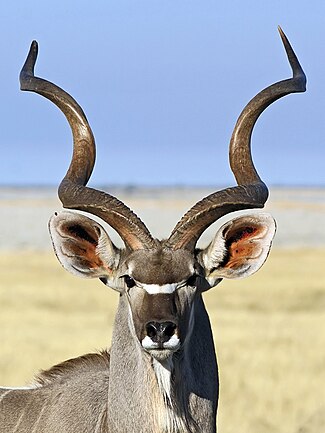
The
greater kudu (
Tragelaphus strepsiceros) is a species of woodland
antelope in the genus
Tragelaphus found throughout eastern and southern Africa. Despite occupying widespread
territory, they are sparsely populated in most areas due to declining habitat, deforestation and poaching. The greater kudu is one of two species commonly known as
kudu, the other being the
lesser kudu,
T. imberbis. Greater kudus have a narrow body with long legs, and their coats can range from brown or bluish grey to reddish brown. They possess between four and twelve vertical white stripes along their torso. The head tends to be darker in colour than the rest of the body, and exhibits a small white chevron running between the eyes. The
helical horns of adult males grow as the animal ages, reaching
2+1⁄2 rotations at about 6 years old.
This picture shows a greater kudu bull photographed near Groot Okevi in
Etosha National Park, Namibia. Bulls weigh 190–270 kg (420–600 lb), up to a maximum of 315 kg (690 lb), and stand up to 160 cm (63 in) tall at the shoulder.
Template:POTD/2020-02-26
The
Cape ground squirrel (
Xerus inauris) is a medium-sized rodent native to South Africa, Namibia and Botswana. They live in social groups of up to three adult females and several sub-adults. The species mainly inhabits
arid or
semi-arid areas, preferring
velds and grasslands with compact soil, and can also be found in
scrub, on floodplains and in agricultural areas. Males live independently, only joining groups when there is a female in
estrus. Ever alert to danger, they can drive off predators such as snakes by engaging in
mobbing behavior.
This picture shows two Cape ground squirrels photographed in the
Namib desert near
Solitaire, Namibia.
Template:POTD/2020-06-01
The
southern plains gray langur (
Semnopithecus dussumieri) is a species of
Old World monkey native to the Indian subcontinent. It is about 62 cm (24 in) tall and lives in groups in various forest habitats, feeding mainly on leaves, fruit and flowers in the
canopy, supplementing these with insects, gum, grasses, herbs and roots. The monkeys are considered sacred in India, and some are used by Hindu priests for religious purposes. They have adapted to living in close proximity to humans in urban settings; they are often fed by humans and accept cakes, millet, and other foods. The species is protected by law in India, but some are still persecuted for damaging crops, hunted for food and captured for pets.
This photograph of a female southern plains gray langur was taken in
Kanha Tiger Reserve, in the Indian state of
Madhya Pradesh. The park was created on 1 June 1955 and was designated a
tiger reserve in 1973.
. It is often referred to as the one-humped camel, Arabian camel, or simply as the "dromedary".

